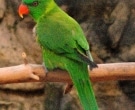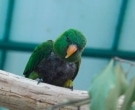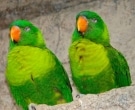Description Lori Flores:
25 cm. length and 100-150 g. of weight.
The Flores Lorikeet (Trichoglossus weberi) is generally Green; light green / blue stripes on the forecrown and lores, the rest of the head with brighter green stripes; underwing-coverts yellow / green. The chest and the thighs are yellowish or reddish. The bill It is orange-red and irises orange-red. The legs son grises. Smaller size than other species Trichoglossus.
The youth they are similar to adults.
taxonomy:
Sometimes you think you're closer Olive headed Lorikeet (Trichoglossus euteles). With one exception, so far it has been treated as a subspecies within the complex Coconut Lorikeet (Trichoglossus haematodus), but differs in its chest rather pale green; abdominal patch medium green; head dark green with streaks of bright green; small size (less than a Scarlet-breasted Lorikeet (Trichoglossus forsteni) relatively small). Monotypic.
- Sound of the Flores Lorikeet. (1)
(1) Some species are under extreme pressure because of traps and harassment. The open availability of high-quality recordings of these species may further worsen problems. For this reason, transmission and download of these recordings is off. Recorders are free to share in xeno-edge, but they will have to approve access to these recordings.
Habitat:
It's more common in the lowlands, but it is up 2400 meters above sea level. Wide variety of areas including settlements, forests, coconut plantations, Savanna, eucalyptus forests and mangroves.
It is found in mixed flocks with other parrots; small and noisy groups. Nomads, since they depend on flowering trees. It perches communally in groups of hundreds of birds.
Reproduction:
Birds have been recorded in conditions reproduction in June and is reported reproduction between February and August (White and Bruce 1986, Reeve y Rabenak 2016).
It will nest on the ground in some of the predator-free islands.
Food:
It feeds mainly from nectar, but also feeds on figs, insects and can be found around artificial feeding stations.
Distribution:
Extensión de la distribución (cría/residente): 25.500 km2
The Lori Flores are endemic to the Flores Island, Indonesia, where it is described as common (pit et to the. 1997).
Conservation Lori Flores:
1. Current category Red List UICN: Near-threatened.
2. The population trend: Decreasing.
3. Population size : 10000-19999 individuals.
Justification of the red list category
It is believed that this species has recently split a moderately small population (approaching 10.000 mature individuals), forming one subpopulation, inferring that is suffering moderately rapid decreases due to the pressure of capture and loss of habitat. Therefore, It has been classified as Near threatened, but more information on population size, trends and threats can lead to a reassessment of their status.
Justification of the population
It is believed that the population of Flores Lorikeet It is moderately small (namely, approaching 10.000 mature individuals).
Justification trend
They suspected that the population is declining due to loss of habitat and unsustainable levels of exploitation.
Threats
The habitat destruction through the combined impacts of firewood collection, commercial logging, timber extraction for construction materials and clearance for agriculture may represent the most relevant threat.
The loss and fragmentation of forests It is already extensive in Flowers, where no semi-permanent forest below 1.000 meters is included within protected areas published in the Official Gazette. These threats are exacerbated by the expansion of human population, with large volumes of timber needed for housing construction, and the fact that the application of the laws by the government is little or no.
Deciduous rain forest is being cut extensively through land grabbing and the establishment of agricultural areas, a factor that is inevitably reducing the range and population of this species. Logging continues in the coastal belt to make way for crops, illegal logging continues in the protected areas.
It is presumed that the capture for trade in wild birds It represents an additional threat, as for other subspecies of the complex (Trichoglossus haemotodus).
In captivity:
In captivity it is kind enough rare de lori. He was raised for the first time Great Britain, in 1969, in Germany in 1984.
Because of its endangered status, Any suitable specimen can not be released back into their natural habitat (native range) It should preferably be placed in a breeding program well managed to ensure the continued survival of this species.
Alternative names:
- Flores Island rainbow lory, Flores Lorikeet, Leaf Lorikeet, Rainbow Lorikeet (Leaf) (inglés).
- Loriquet à tête bleue (Weber), Loriquet à tête bleue (weberi), Loriquet de Flores, Loriquet de Weber (francés).
- Flores Blauwangenallfarblori, Flores-Allfarblori, Webers Lori (alemán).
- Periquito-arco-íris (weberi) (portugués).
- Lori de Flores, Lori Arcoiris (weberi) (español).
Scientific classification:
- Orden: Psittaciformes
- Familia: Psittaculidae
- Género: Trichoglossus
- Nombre científico: Trichoglossus weberi
- Citación: (Büttikofer, 1894)
- Protónimo: Psitteuteles weber
Flores Lorikeet images:
Flores Lorikeet (Trichoglossus weberi)
-
Sources:
1. Avibase
2. Parrots of the World – Forshaw Joseph M
3. Parrots A Guide to the Parrots of the World – Tony Juniper & Mike Parr
4. Birdlife
Photos:
(1) – Flores Lorikeet, Trichoglossus (haematodus) weberi, at New Port Aquarium, Cincinnati, USA by derivative work: Snowmanradio (talk)Trichoglossus_haematodus_weberi_-New_Port_Aquarium-8.jpg: Serge Melki [CC BY 2.0], via Wikimedia Commons
(2) – Weber’s Lorikeets (Trichoglossus haematodus weberi) at Newport Aquarium by Ltshears [CC BY-SA 3.0 or GFDL], from Wikimedia Commons
(3) – Fig. 1: Flores Lorikeet (Trichoglossus = Psitteuteles Weber Weber)
Fig. 2: Olive-headed Lorikeet (Trichoglossus euteles = Psitteuteles euteles) by A Weber’s lorikeet (Trichoglossus weberi) at the Jerusalem Biblical Zoo by SuperJew [CC BY-SA 4.0], from Wikimedia Commons
(4) – Trichoglossus haematodus weberi Buttikofer, 1894 bt Huub Veldhuijzen van Zanten / Naturalis Biodiversity Center [CC BY-SA 3.0]
(5) – Weber’s lorikeet, Picture taken at Loro Parque in Puerto de la Cruz / Tenerife by Dominik Deobald – Flickr
(6) – Johann Büttikofer [Public domain], via Wikimedia Commons
– Sounds: Raf Floats, XC350575. accessible www.xeno-canto.org/350575






